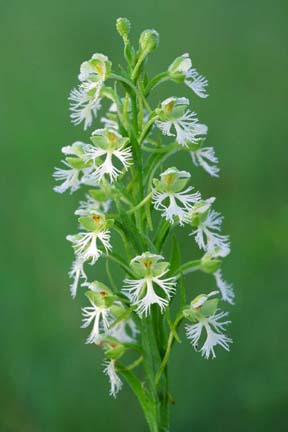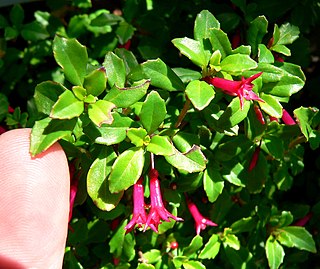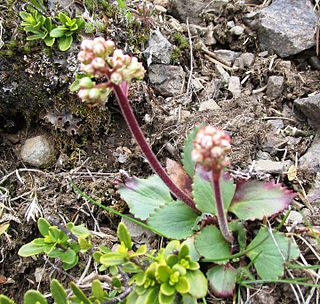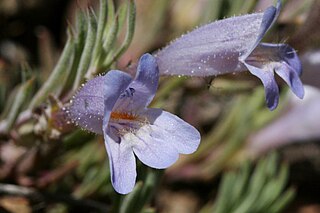
Butomus umbellatus is a Eurasian plant species in the family Butomaceae. It is the only species in the family. Common names include flowering rush or grass rush. Introduced into North America as an ornamental plant it has now become a serious invasive weed in the Great Lakes area and in parts of the Pacific Northwest. In Israel, one of its native countries, it is an endangered species due to the habitat loss. It can also be found in Great Britain locally, for example at the Caldicot and Wentloog Levels The plant is a rhizomatous, hairless, perennial aquatic plant. Its name is derived from Greek bous, meaning "cow", "ox" etc. and tome, a cut, which refers to the plant's swordlike leaves.

Angelica is a genus of about 90 species of tall biennial and perennial herbs in the family Apiaceae, native to temperate and subarctic regions of the Northern Hemisphere, reaching as far north as Iceland, Lapland, and Greenland. They grow to 1–3 m tall, with large bipinnate leaves and large compound umbels of white or greenish-white flowers. Found mainly in China, its main use was for medicine. It shows variations in fruit anatomy, leaf morphology, and subterranean structures. The genes are extremely polymorphic.

Acer grandidentatum, commonly called bigtooth maple, is a species of maple native to interior western North America. It occurs in scattered populations from western Montana to central Texas in the United States and south to Coahuila in northern Mexico.

Platanthera leucophaea, commonly known as the prairie white fringed orchid or eastern prairie fringed orchid, is a rare species of orchid native to North America. It is a federally threatened species, protected since October 30, 1989 under the Endangered Species Act of 1973. In Canada, it has been listed endangered under Schedule 1 of the Species at Risk Act since 2005. In 2014, the International Union for Conservation of Nature assessed it as "least concern."

Dasylirion wheeleri is a species of flowering plant in the asparagus family (Asparagaceae), native to arid environments of northern Mexico and the southwestern United States.

Smilax rotundifolia, also known as roundleaf greenbrier or common greenbrier, is a woody vine native to the southeastern and eastern United States and eastern Canada. It is a common and conspicuous part of the natural forest ecosystems in much of its native range. The leaves are glossy green, petioled, alternate, and circular to heart-shaped. They are generally 5–13 cm long. Common greenbrier climbs other plants using green tendrils growing out of the petioles.
Chaetadelpha is a genus of plants in the family Asteraceae containing the single species Chaetadelpha wheeleri, or Wheeler's skeletonweed. This brushy perennial plant is native to the western United States.

Arctostaphylos confertiflora is a rare species of manzanita known by the common name Santa Rosa Island manzanita. This shrub is endemic to California, where it grows on the sandstone bluffs of Santa Rosa Island in the Channel Islands. This manzanita is listed as an endangered species by the United States Government.

Senecio flaccidus, formerly recorded as Senecio douglasii, member of the daisy family and genus Senecio also known as threadleaf ragwort, is a native of the southwestern Great Plains of North America.
Amaranthus watsonii is a species of amaranth known by the common name Watson's amaranth. It is native to the southwestern United States and northern Mexico, where it grows in sandy places such as deserts and beaches, and disturbed areas. It is also known as a rare introduced species in parts of Europe. This is an erect annual herb producing a glandular hairy stem to a maximum height of about a meter. The leaves are generally oval-shaped and up to 8 centimeters long, with a petiole of up to 9 centimeters. The species is dioecious, with male and female individuals producing different types of flowers. The inflorescence is a long spike cluster of flowers interspersed with spiny green glandular bracts. The fruit is a smooth capsule about 2 millimeters long that snaps in half to reveal a small shiny reddish black seed.

Angelica capitellata, synonym Sphenosciadium capitellatum, is a species of flowering plant in the family Apiaceae. When treated as Sphenosciadium capitellatum, it was the only species in the monotypic genus Sphenosciadium. It is known by the common names woollyhead parsnip, ranger's buttons, button parsley, and swamp white heads.

Peperomia wheeleri is a rare species of flowering plant in the pepper family known by the common name Wheeler's peperomia. It is endemic to Puerto Rico, where it is known only from the island of Culebra. It has become rare because of deforestation and grazing by livestock. It is a federally listed endangered species of the United States.

Gaylussacia frondosa is a species of flowering plant in the heath family known by the common names dangleberry and blue huckleberry. It is native to the eastern United States, where it occurs from New Hampshire to South Carolina.

Holodiscus dumosus is a species of flowering plant in the rose family, with the common names mountain spray, rock-spiraea, bush oceanspray, and glandular oceanspray.

Symphyotrichum georgianum is a rare species of flowering plant in the Asteraceae, the aster family. Its common name is Georgia aster. It is native to the southeastern United States where it is known from Alabama, Florida, Georgia, North Carolina, and South Carolina. As of 2013, it may be extirpated from the state of Florida.

Carex lacustris, known as lake sedge, is a tufted grass-like perennial of the sedge family (Cyperaceae), native to southern Canada and the northern United States. C. lacustris us an herbaceous surface-piercing plant that grows in water up to 50 cm (1.6 ft) deep, and grows 50–150 cm (1.6–4.9 ft) tall. It grows well in marshes and swampy woods of the boreal forest, along river and lake shores, in ditches, marshes, swamps, and other wetland habitat. It grows on muck, sedge peat, wet sand or silt, in filtered or full sunlight.

Lespedeza virginica, known as slender bush clover or slender lespedeza, is a species of flowering plant native to much of the United States, as well as Ontario, Canada, and Nuevo León, Mexico. It is a member of the bean family, Fabaceae.

Fuchsia microphylla, also known as small leaf fuchsia and small-leaved fuchsia, is a flowering shrub in the family Onagraceae. The specific epithet (microphylla) was named for the plant's small (micro) leaves (phylla).

Micranthes occidentalis, commonly known as western saxifrage, is a species of flowering plant native to North America.

Penstemon caespitosus, commonly known as mat penstemon, is a summer blooming perennial flower in the large Penstemon genus. It is a widespread plant from near timberline to the foothills in the Southern Rocky Mountains and Colorado Plateau in North America. It is noted for its ground hugging growth habit and as a plant used in xeriscape and rock gardening.



















